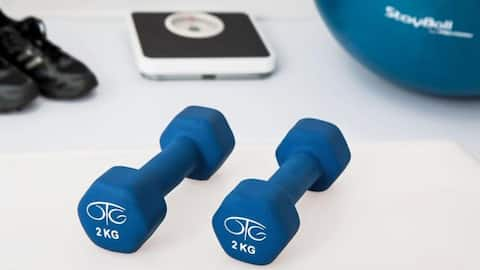Exercise's impact on weight loss varies: Kobe University study
What's the story
A research team from Kobe University, led by endocrinologist OGAWA Wataru, has discovered why some individuals lose weight slower after workouts.
The study focused on variations of a signal molecule that connects exercise and its effects.
Ogawa explained that the new versions of PGC-1a—a protein that appears to link exercise and its effects—known as "b" and "c," function almost the same as the conventional "a" version.
However, these new versions are produced in muscles more than 10-fold during exercise.
Experiment details
Mice study reveals weight gain susceptibility
The Kobe University team studied mice that were unable to produce signal molecules responding specifically to short-term exercise and regulating energy metabolism.
These mice consumed less oxygen during workouts, burned less fat, and were more prone to weight gain.
The researchers hypothesized that the newly discovered versions of the molecule, not the previously known one, regulated energy metabolism during workouts.
Trial results
Human trials confirm mice study findings
To validate their theory, the researchers created mice lacking the "b" and "c" versions of the signal molecule PGC-1a while retaining the standard "a" version.
They measured muscle growth, fat burning, and oxygen consumption during rest and short-term as well as long-term workouts in these mice.
Similar tests were conducted on human subjects with and without type 2 diabetes.
The results confirmed that individuals lacking the alternative "b" and "c" versions consumed less oxygen and burned less fat during workouts.
Exercise benefits
Long-Term exercise boosts muscle mass, study finds
The researchers also found that long-term exercise stimulated production of the standard "a" version of PGC-1a.
Mice that exercised regularly over six weeks showed an increase in muscle mass, regardless of their ability to produce the alternative versions of the molecule.
Ogawa summarized that the hypothesis that the genes in skeletal muscle determine susceptibility to obesity was correct.
The team's findings were published in the journal Molecular Metabolism.
Cold effects
Cold exposure increases body fat, research reveals
The team also studied the production of different versions of PGC-1a in fat tissues and found no significant effect in response to exercise.
However, they discovered that production of the "b" and "c" versions increased when animals were exposed to cold, affecting their ability to maintain body temperature.
This could contribute to these individuals having more body fat.
The findings provide new insights into the physiological activity of different versions of PGC-1a.
Future implications
New obesity treatments could emerge from study
Understanding the physiological activity of different versions of PGC-1a could lead to new treatments for obesity, according to Ogawa's team.
Ogawa stated that if a substance that increases the "b" and "c" versions can be found, this could lead to the development of drugs that enhance energy expenditure during exercise or even without exercise.
The team is now conducting further research into the mechanisms that lead to increased production of the signal molecule's "b" and "c" versions during exercise.
